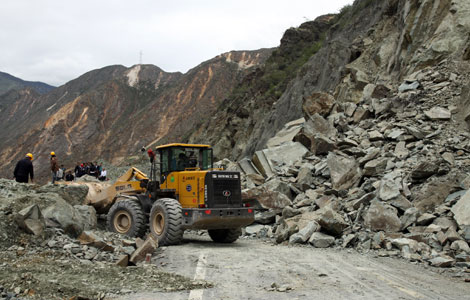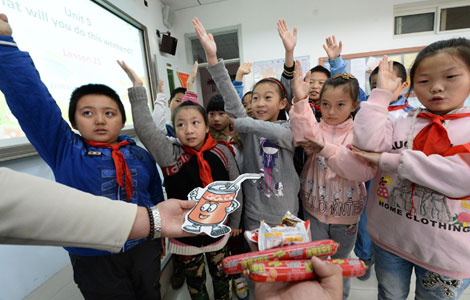New engine for development
Updated: 2013-10-25 07:04
By Zhou Tianyong (China Daily)
|
||||||||
Innovation-powered growth is essential if China is to avoid being left behind in the technological revolution
At a group study session of the central leadership in September, Party leader Xi Jinping stressed that the implementation of the strategy of innovation-driven development will decide the future of the Chinese nation. He urged the Party and society to grasp the trend of global science and technological innovation and seize the opportunities offered by the technological revolution and implement innovation-driven development as a key strategy for the future.
Indeed, China has come to a stage of development that commands innovation-powered growth. The more developed an economy becomes, the bigger the contribution knowledge and technology make to its growth. Thanks to the 30-plus years of reform and opening-up, China's GDP per capita, once ranked low worldwide, rose to about $6,100 in 2012, signifying it is time to make the transition from capital and resources-driven growth to innovation-motivated growth.
China has advantages in science and technology innovation, including a huge talent pool. Over the years, secondary school students from China have performed impressively in global mathematics, physics and chemistry competitions and every year about 2 million students majoring in engineering graduate from college. Meanwhile, the number of those who study abroad and return to China is on the rise, so is the number of scientists and technicians. The value of human capital nationwide is estimated to be between 200 to 300 trillion yuan ($33-48 trillion).
Moreover, China has raised its research and development input substantially. It now accounts for about 2 percent of the country's GDP and 14 percent of the world's total R&D input. The country's research equipment is also a far cry from that of the old days. Today, China boasts an ever-improving innovation system featuring distinct R&D capabilities that combine universities, corporate R&D centers, research institutes and key laboratories at State, provincial and city levels. China is also taking the lead in a wide range of scientific and technological areas, including rice hybrids, intelligent robots and cloud computing. With the aforementioned advantages, China should be full of confidence in implementing the strategy of innovation-driven development.
As it presses ahead with the strategy, China will enjoy a period of strategic opportunities. Over the years of the reform and opening-up drive, China has achieved an economic miracle that has benefited from the country's low-cost labor. Today, scientific and technological professionals in the country, despite enjoying the same fruits of economic development, still have comparatively lower incomes than their Western counterparts. This, together with the competitive prices of research equipment in the country, will provide a period of strategic opportunities featuring low-cost R&D that China cannot afford to miss.
After two debt crises, the United States, European countries and Japan, the traditional science and technology powerhouses, have focused on facilitating scientific and technological progress to maintain their competitive edge and create more job opportunities by renewing consumption through innovation. New technologies will inevitably reduce employment in the manufacturing sector, but they will boost more personalized designs and production that help create new jobs.
Developed countries, such as the US, have had success in employing scientific and technological innovation to revive their economies even amid recession. From the 1980s onward, corporate alliance in the field of science and technology has grown by 10 percent on average on a yearly basis. High-tech trade has doubled its contribution to the exports and imports of the manufacturing sector. The US recorded rapid growth in the 1990s, for which scientific and technological advances were the most important source of impetus. In the new century the deepening development of information technology and the shale gas revolution have also played a key role in cushioning the US against the economic downturn and forged the conditions necessary for the US' re-industrialization and manufacturing revival. These are lessons China can learn from the US.
Despite the obvious advantages, however, China should be aware of the challenges posed by the world's third industrial revolution and the re-industrialization of the Western world. The 21st century is witnessing the growing importance of technology and the green development pathway. If China fails to accomplish something concrete and significant, it will be downgraded to a second or even third-tier country. Should China fail to realize self-innovation, it will face the risk of becoming a dumping ground for outdated technologies and equipment. Industries awash with excess capacity may spread from traditional to emerging ones, as technologies further upgrade and ways of production and spending are directed toward an ecologically friendly way.
If China succeeds in raising the 50 percent contribution of science and technology to economic growth by 1.5 percentage points every year, then innovation-driven GDP growth will be equivalent to about 1 trillion yuan ($163 billion), and accordingly the pace of economic growth will rise by 1.8 percentage points. With greater importance attached to innovation and concrete implementation of the strategy of innovation-driven development, the Chinese economy will harvest even greater dividends. The constant progress in science and technology and the development of newly emerging industries will produce a steady momentum for China's economic growth.
The Chinese version of the article appeared in Study Times.
(China Daily 10/25/2013 page8)

 Serena completes dominant season with triumph
Serena completes dominant season with triumph
 Nuclear submarine fleet comes of age
Nuclear submarine fleet comes of age
 5 pharmacies begin to sell baby formula
5 pharmacies begin to sell baby formula Mother and four children stabbed to death in New York
Mother and four children stabbed to death in New York
 China Fashion Week S/S 2014: day 2
China Fashion Week S/S 2014: day 2
 Demonstrators protest against govt surveillance in US
Demonstrators protest against govt surveillance in US
 Where art thou, my love?
Where art thou, my love?
 Li Na reaches WTA Championships final
Li Na reaches WTA Championships final
Most Viewed
Editor's Picks

|

|

|

|

|

|
Today's Top News
High speed versus history
Southern states gear up for symposium
Film finds a hip-hop-tai chi connection
Jewelry exhibit dazzles Southern California
Obama aware of spying on Merkel: German paper
Five stabbed to death in NYC
Forum urges stable China-Japan ties
NSA spying hurts US diplomacy
US Weekly

|

|






